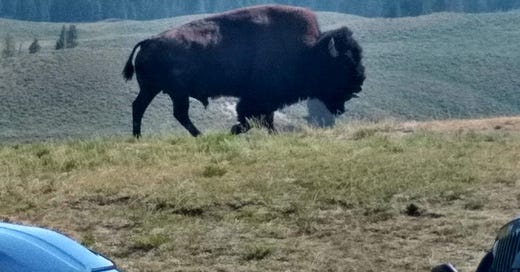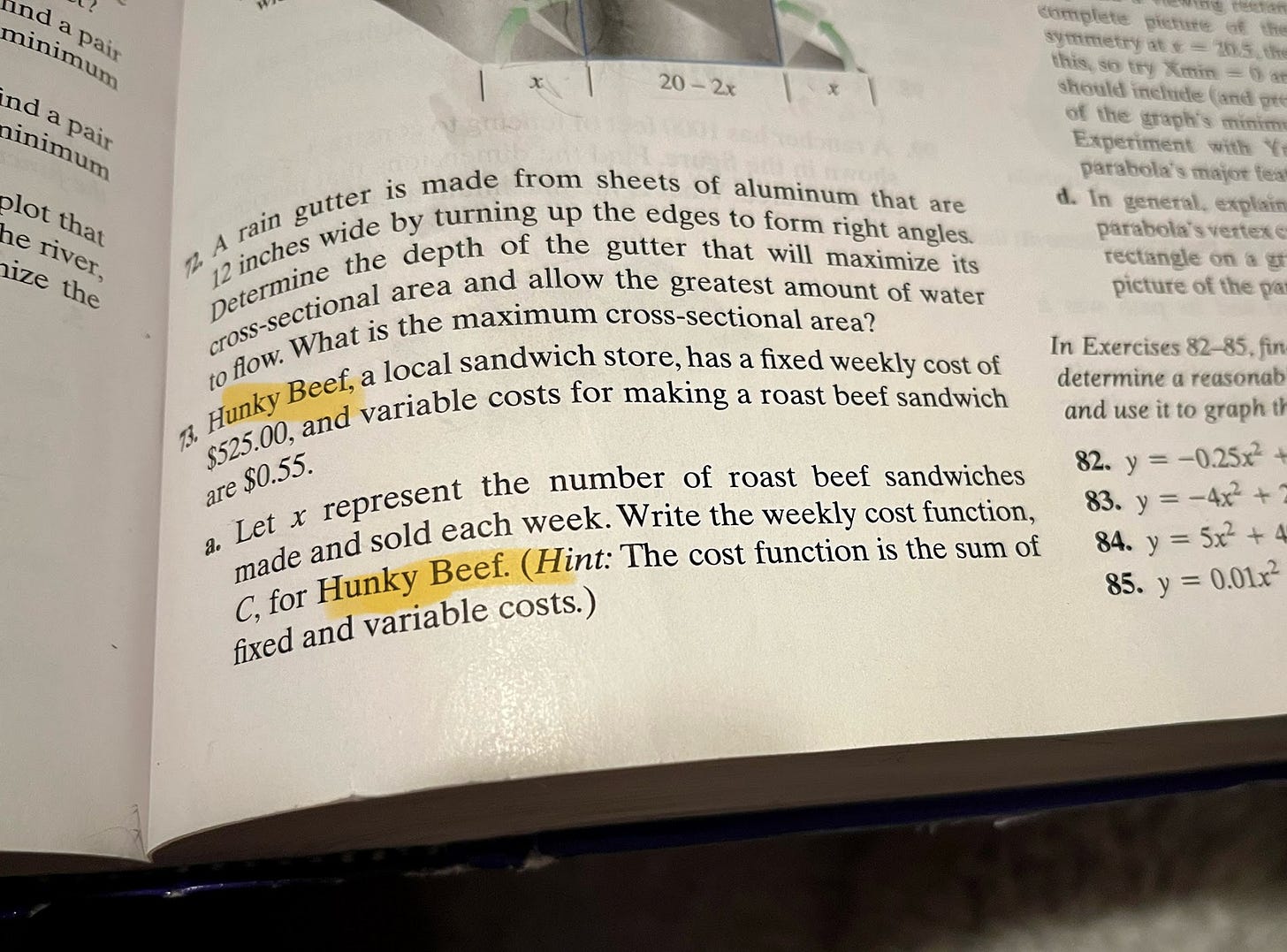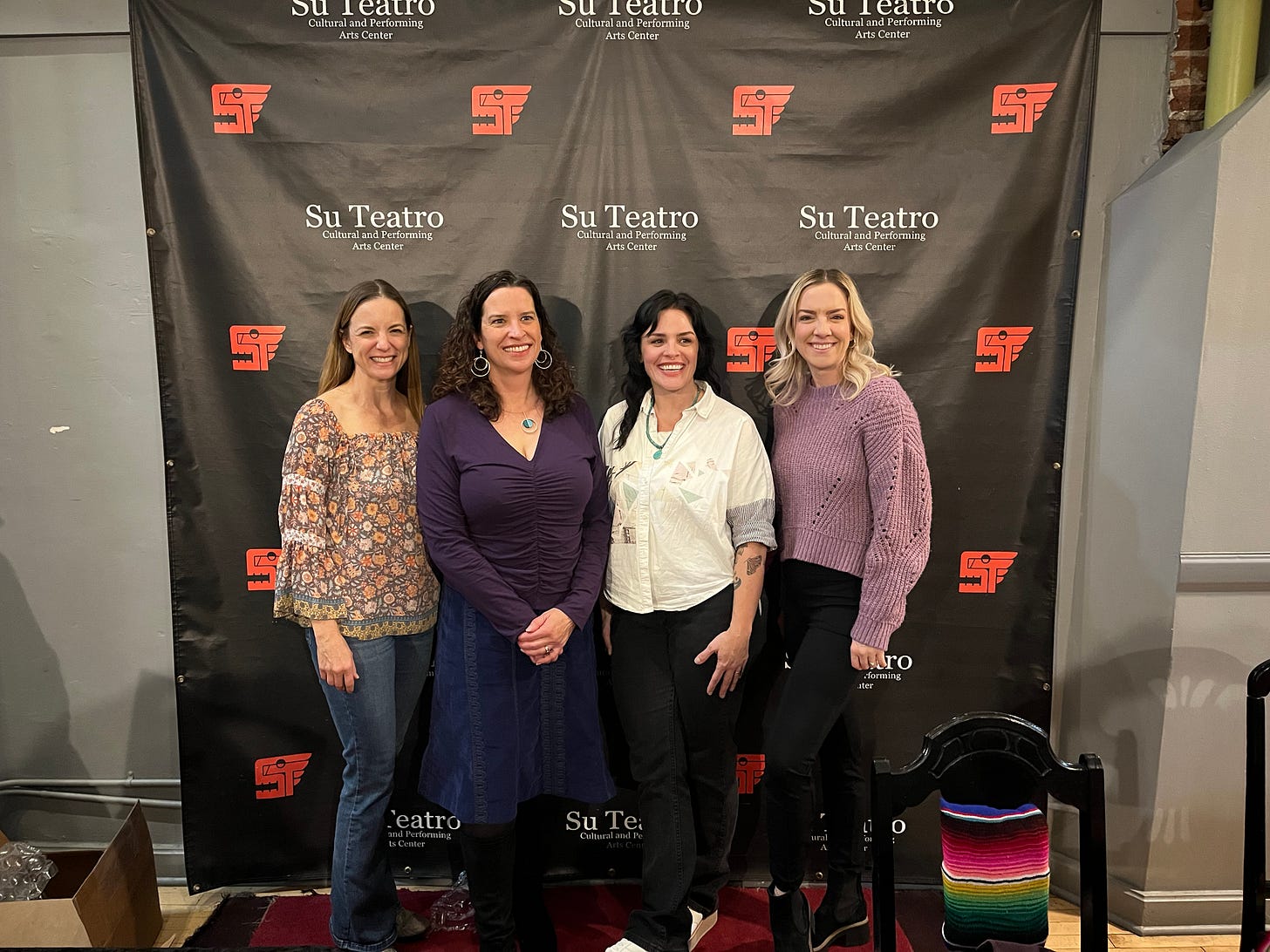Pipe Down Haters, Ralphie VI is Brat
A deliberate bison showcases the beauty of individuality, a saucy algebra book risks a ban, and some new book recommendations.
National Bison Day is observed the first Saturday in November, but here at the Tumbleweed we celebrate Bison Month. Not only is the bison our national mammal, but a certain bison is one of my favorite neighbors: Ralphie VI. Ralphie VI, nicknamed Ember, is the current mascot for the University of Colorado. Her job is to charge out of her trailer before football games and run a lap as the team takes the field. As you can tell by her name, there have been several prior Ralphies. Unfortunately, some fans are comparing the current Ralphie’s performance to that of the previous bison, and they are finding her lacking.
The preceding Ralphies charged from one end zone to the other, while four or five sprinting cowboys clung to the animal’s ropes, giving the impression that the Ralphie was always a hairsbreadth away from a stampede. However, Ralphie VI prefers not to run.
When Ralphie VI’s handlers released her from her trailer before the October 14 Kansas State game, the cowboys had to coax her along, almost tugging her, and she only made it to the 40 yard line, which was farther than she’d ventured on prior outings this season. On October 26, she managed to trot to the 45 yard line, which prompted some uncharitable observers to declare, “Ralphie is washed.”
She's only four years old, so she's young enough. She's just not into the whole scene. People are bombarding Ralphie’s official Instagram with comments, imploring her to retire, saying that we should move on to Ralphie VII.
According to Wikipedia, the prior Ralphie “was known as the most powerful and fastest of all the Ralphies.” That means many observers are comparing Ralphie VI to Ralphie V, and judging her lacking. Which I think is entirely the wrong way to look at the situation.
Did any of us ever pause to contemplate Ralphie V, who burst out of her cage and completed the required 100 yard sprint with vigor each time, seeming a little pissed, dragging those cowboy handlers? Most of us cheered for Ralphie V, but then didn’t give her another thought.
On the other hand, Ralphie VI has me thinking a lot. About the particularity of each individual living creature. About how steadfast she is in her idiosyncrasies that when she is confronted with a system designed to force her to perform one task, she responds by fulfilling the system’s demands with her own particular flair. Ralphie VI is a free and independent animal, and she shows you that every time she takes the field. That’s what freedom looks like: your right to act like Ferdinand the Bull and smell flowers rather than engaging in the expected, clichéd charging, snorting, and goring. In her insouciance, in her sauntering, Ralphie VI is the mascot who most clearly embodies the independent spirit of the American West. I’ll even go further: Ralphie is Brat.
“Prance, Ralphie, Prance,” a local sports analyst tweeted about that 40-yard run, and I agree. What is a mascot for? Primarily to inspire, entertain, and bring the team good luck. Ralphie VI is extremely entertaining, because you never know exactly what she’ll do each time she runs. She surprises you, like all expert entertainers. She is inspiring to all who have ever felt like they can’t possibly live up to expectations or norms, but that they nevertheless have a unique and valuable contribution to make to the world.
And this Ralphie, who began appearing at games in 2021, is clearly good luck, overseeing a historic comeback for the team, which is now ranked 16th in the nation by the AP and boasts a charismatic coach, a quarterback who makes people scream and swoon, and a Heisman Trophy contender. Nothing about CU is anything like it has ever been before. Why should we expect the current Ralphie to be a copy of the bison that proceeded her?
Any institution that wants to get the best out of its participants has to treat them like the individuals they are. To those who think Ralphie VI is a failure, I say instead, your metric for success might be.
Before the November 16 game, Ralphie emerged from her trailer with her characteristic unbothered saunter, and headed toward the CU Buff logo at the center of the field. She ambled for 50 yards, but then, as she turned around, she decided to run. She cantered so hard that several of her cowpeople lost their hats. “All right, there we go,” said one of the ESPN announcers. Ralphie’s front attendant looked ecstatic, his mouth agape and his hair flying, as if he’d been training for this moment for years, a full-out sprint next to a charging bison, and finally Ralphie had obliged.
Ralphie did this on her own terms, in her own time. She might be the most dignified and lovable bison the world has ever seen.
The Assorted Whimsy Portion of The Tumbleweed
Speaking of free and independent spirits, I want to praise the author of my son’s algebra book, who went ahead and named the sandwich shop in this story problem “Hunky Beef,” even if it got the textbook banned in Florida.
The Book Recommendation Portion of The Tumbleweed
I have two fabulous novels to share with you this month, as I gear up for next month’s annual Jenfolk Book Awards.
In Cara Lopez Lee’s engrossing novel Candlelight Bridge, two complex protagonists flee their home countries and unite in El Paso in 1912. Twelve-year-old Candelita and her family head north from Chihuahua to escape the turmoil of revolutionary war. Meanwhile in China, twenty-year-old Wong Yan Chi is set to marry and settle into a comfortable life, but fate has other plans. When they meet working in a Chinese restaurant in El Paso, they are reeling in the aftermath of violence that claimed loved ones, trying to establish stability. Yan Chi and Candelita marry during an era when their ethnicities make them targets. For inspiration, Lopez Lee drew on her own heritage and family tales. Her commitment to this story shows in the authentic details, depth and sensitivity of characterization, meticulous historical research, honed prose, and her unflinching take on the sacrifices women make to steer their families through hard times.
In Alexander Sammartino’s impressive debut novel Last Acts, David Rizzo is a down-on-his-luck, divorced owner of a gun shop in an ailing, little-visited Phoenix strip mall. Rizzo might be losing his house, livelihood, and sanity when he catches a break: his son Nick overdosed but sprang back from the dead, wants to get clean and return to his father’s good graces. David was about to sign Rizzo’s Firearms over to a “sham developer of the desert” but now feels a renewed sense of possibility. With his son by his side, he yearns for a comeback. “All his life he had waited for a sign from above. Here it was, his estranged son, back for a reason.” He features Nick’s resurrection on a TV commercial, pledges donations to help addicts, and the guns begin to fly off the shelves. But the Rizzo men’s good fortune can’t last. Sammartino writes funny, punchy, inventive prose and his debut novel introduces him a talented storyteller of Southwest seediness, American decline, and misguided hope for reinvention.
The Happenings & Links Portion of The Tumbleweed
The Stories on Stage show “Mixed Company” featuring three of my stories read by brilliant actors Noelia Antweiler, MacKenzie Beyer and Anne Marie Nest at Su Teatro November 10 was one of the highlights of my writing career. I’d never seen my work interpreted by another artist before, and I was amazed at all the layers they discovered and brought out in their performances. Thank you to all my family, friends, students, and rec center bootcamp buddies who came to see the show!
My next four-week Lighthouse class is for nonfiction aficionados: Personal Essays: From the Particular to the Universal. It runs on Mondays from February 3 to February 24 on Zoom, from 6:30-8:30 p.m. If you have ideas for personal essays you want to write, but don’t know how to structure them, get started, or craft them so your personal story will grip readers who don’t know you, this is the class for you!
I was honored to contribute a piece to the splendid anthology We Can See Into Another Place: Mile-High Writers on Social Justice, and Teague Bohlen recently interviewed editors Andrea Rexilius and Heather Garbo for Westword about the project.
I’m going to be on a panel at the upcoming AWP conference in Los Angeles in March called “Making the Cut: What Judging Story Collection Contests Taught Us.” Led by Flannery O’Connor Prize editor Lori Ostlund, I’ll be talking about what made story collections stand out to me, alongside my fellow screener judges Toni Ann Johnson, Michael Wang and Hasanthika Sirisena.
I have openings for one-on-one editorial work and writing and publishing coaching from November and beyond. Let me know if I can help you!
As always, The Tumbleweed welcomes your questions and comments about writing, reading, taco eating, the Denver Nuggets, rabbit wrangling, Deion Sanders, and baby seals.







